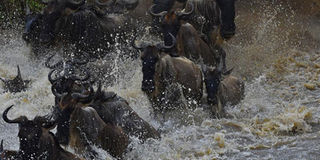Bad weather forces wildebeests to delay calving

Herds of wildebeest cross the river in Masai Mara on September 4, 2015. The wildebeests head to Ndutu, South of the Serengeti National park, where they start breeding. PHOTO | AFP
What you need to know:
- Serengeti is home to more than 2.5 million wildebeests that reproduce annually to bring 500,000 new ungulate calves every January and February.
ARUSHA
Over two million wildebeests that were supposed to give birth to 500,000 new calves this year reportedly delayed their reproduction exercise biologically, waiting for rains.
And when the precipitation took longer, they shifted their breeding location.
Mr Susuma Kusekwa, the Senior Tourism Promotion Officer for the Tanzania National Parks (TANAPA) said today that the wildebeests are capable of holding on to pregnancy for an extended 2 or 3 months, awaiting favourable conditions before releasing their babies into the world.
But, the official said that effects of climate change have driven millions of ungulates that were supposed to give birth to nearly 500,000 new wildebeest calves in Serengeti National Park and parts of Ngorongoro Conservation Area, to relocate their breeding sites to central parts of the Tanzania’s second largest sanctuary.
“This is the first time this is happening and we fear that, increasing number of livestock, especially cattle, in Ngorongoro, has also scared the wildebeests from venturing further south, where livestock have eaten all grass,” added Mr Kusekwa.
“Normally the wildebeests, after crossing back to Tanzania from Maasai Mara game reserve, they head to Ndutu area, South of the Serengeti National park straddling the Northern Section of Ngorongoro Conservation where they start their annual breeding process from January to February,” explained Paschal Shelutete, TANAPA, Principal Public Relations Officer.
"But this year, the ungulates did not venture beyond Naabi hills, but remained in the central parts of Serengeti, mostly Seronera where the calving, albeit a delayed one is currently taking place and this strange shift of behaviour seems to baffle conservationists.
Mr William Mwakilema, Chief Conservator for Serengeti National Park, said there are many factors that could have contributed to the wildebeests shifting their calving precinct from South to Central Serengeti, including delayed rains in the Northern Ngorongoro.
“Seronera and other sections of Central Serengeti received precipitation earlier than the Southern areas that suffered drought and for the wildebeests to give birth to calves they need tender grass sprouting from the early rains,” explained Mr Mwakilema.
Serengeti is home to more than 2.5 million wildebeests that reproduce annually to bring 500,000 new ungulate calves every January and February.





